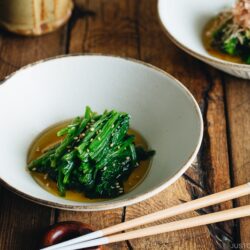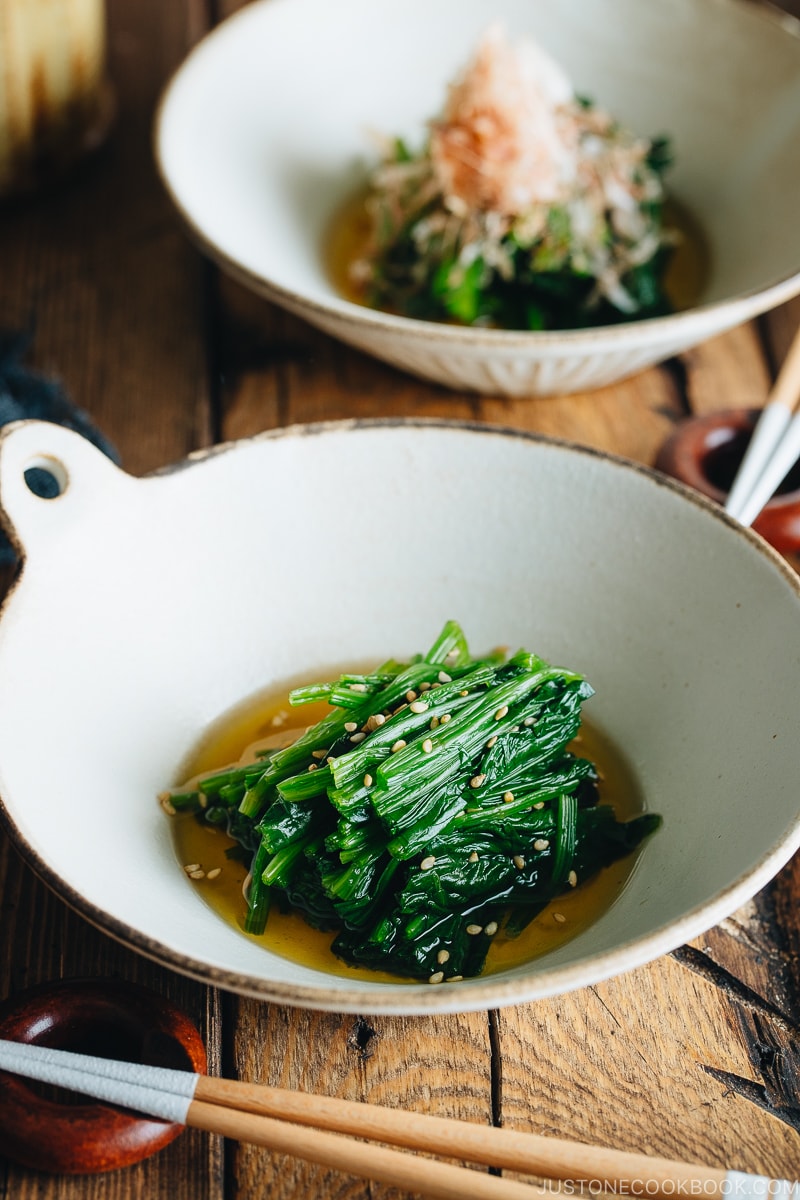
Do you know what type of recipes Just One Cookbook readers request most? They are side dishes and vegan recipes! Today, I’m happy to introduce a classic Japanese side dish with a vegan-friendly option!
My recipe for Spinach Ohitashi (ほうれん草のお浸し) is a Japanese spinach salad with a savory broth. This recipe uses a simple method called ohitashi that’s of the classic Japanese cooking techniques for vegetable side dishes. I think you’ll love this dish and I can’t wait for you to try it at home.
What is Ohitashi?
Ohitashi (お浸し) refers to a dish in which vegetables are steeped in a dashi-based sauce. It’s a common Japanese cooking technique we use for preparing vegetable dishes. This method infuses the ingredients with the Japanese soup stock’s umami and subtle flavor but still retains the vegetable’s natural taste.
To make ohitashi, you first blanch the vegetable, then halt the cooking in an ice bath. Afterward, allow the vegetable to absorb the dashi-based sauce.
We typically serve ohitashi with a sprinkle of katsuobushi (dried bonito flakes) on top. For today’s recipe, I included a vegan-friendly version:
- Vegan-friendly version: Use vegan-friendly Kombu Dashi for steeping and garnish with toasted sesame seeds instead of katsuobushi.
- Regular version: If you prefer a more prominent dashi flavor, use Awase Dashi, a combination of both kombu and katsuobushi.
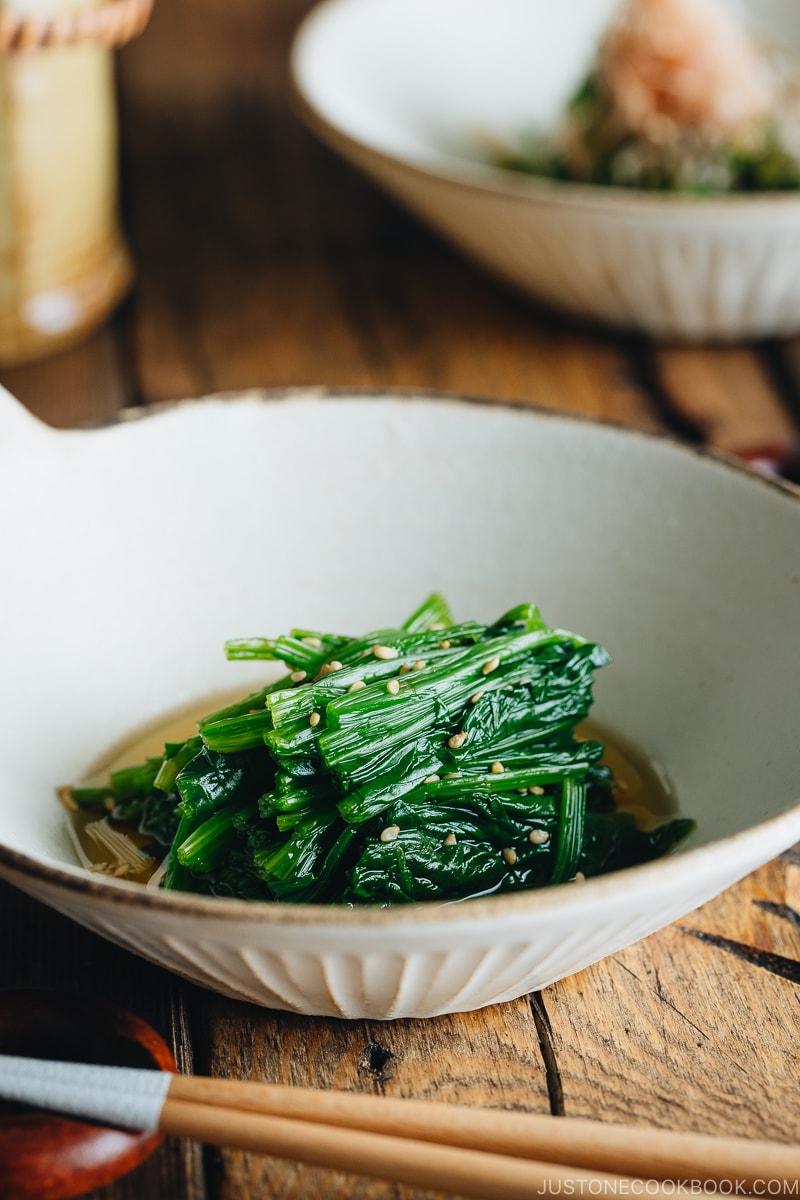
Ingredients for Spinach Ohitashi
- spinach
- Diamond Crystal kosher salt
- water – or you can use awase dashi or vegan dashi and skip the kombu
- kombu (dried kelp) – or substitute a dashi packet or powder
- mirin (Japanese sweet rice wine)
- usukuchi (light-colored) soy sauce
- katsuobushi (dried bonito flakes) – for garnish; skip for vegan/vegetarian
- toasted white sesame seeds – for garnish
How To Make Spinach Ohitashi
- Make the savory broth by boiling the dashi, mirin, and soy sauce. Turn off the heat and set aside to cool.
- Cook the spinach for roughly 1 minute in a large pot of boiling water with a pinch of salt. Start with the stem end; after 15 seconds, push down the leafy part into the boiling water.
- Remove and cool in an ice bath.
- Squeeze out the water from the spinach.
- Cut the spinach into 1½-inch (3.75-cm) lengths.
- Soak the spinach in the broth in an airtight container for 1–4 hours.
- Serve in small individual bowls and pour some broth on top. Sprinkle with sesame seeds and katsuobushi (dried bonito flakes) on top (skip for vegan/vegetarian).
Spinach ohitashi keeps in the refrigerator for up to 3 days.
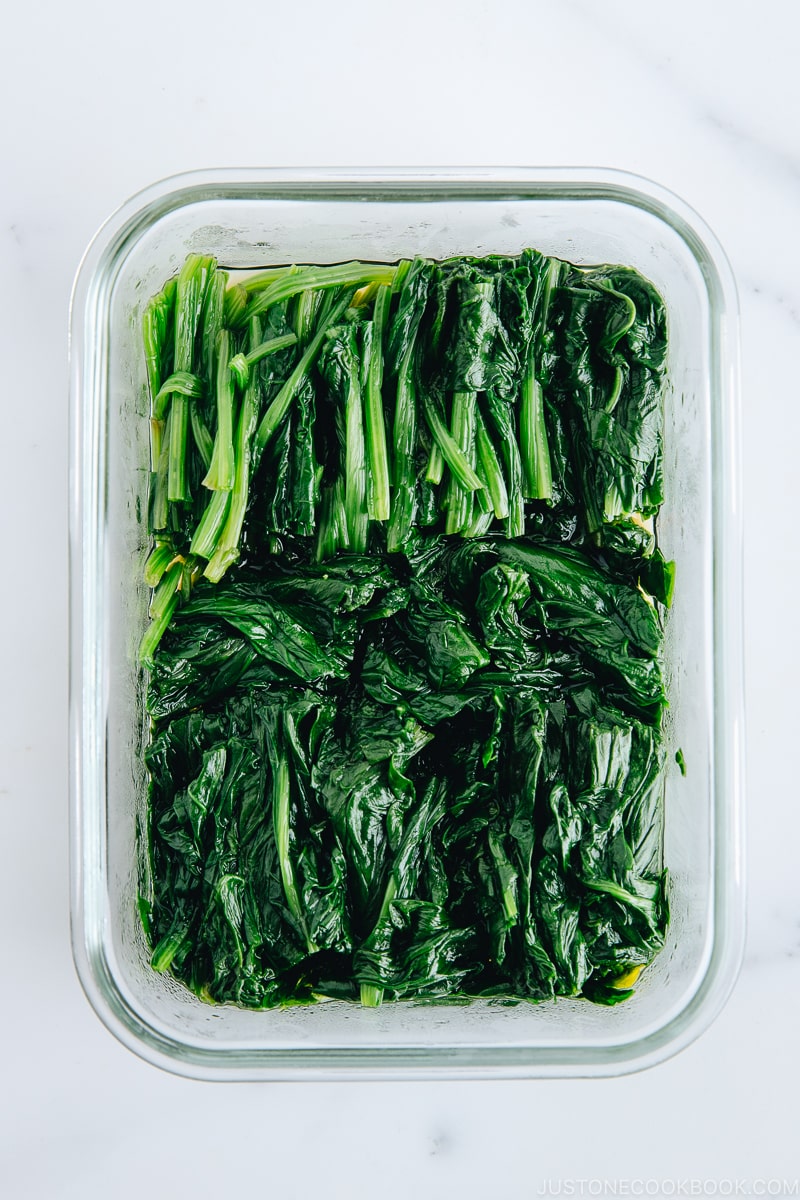
Serve Spinach Ohitashi with Your Japanese Meal
A typical Japanese meal consists of steamed rice, miso soup, main dish, and side dishes. This set meal is called ichiju sansai (一汁三菜) and you can read more about it in my detailed post.
A Japanese set meal encourages you to eat a balanced diet. You’ll find each dish presented in individual serving dishes. Side dishes are usually in a kobachi (小鉢, literally meaning “small bowl”). As a result of this attentive arrangement, we can easily control the portion of the food.
Here are a few suggestions that I would serve with spinach ohitashi:
Rice
Miso Soup
Main Dish
- Eggplant Miso Dengaku
- Warm Mushroom Salad
- Mapo Tofu
- Grilled Mackerel
- Nikujaga (Meat and Pork Stew)
- Baked Tonkatsu
- Teriyaki Steak Rolls
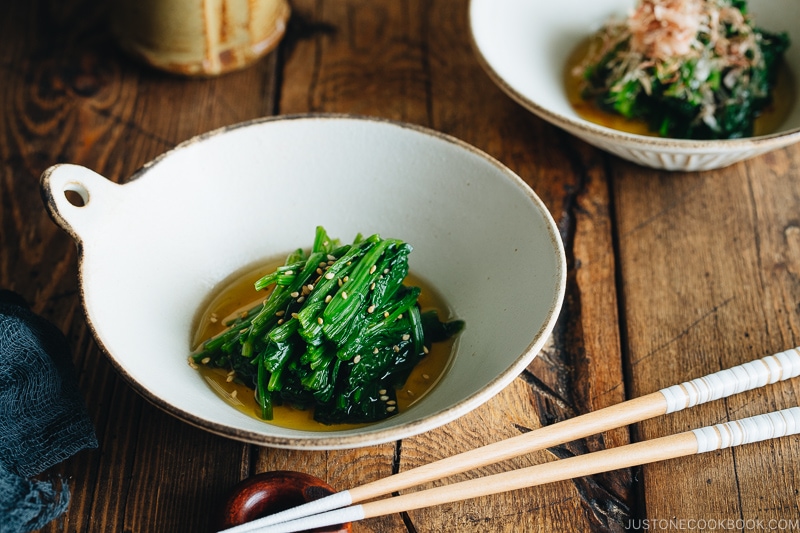
Side Dishes
- Chilled Tofu
- Hijiki Seaweed Salad
- Kinpira Renkon (Stir-Fried Lotus Root)
- Simmered Kabocha
- Kinpira Gobo (Stir-Fried Burdock Root)
- Spinach Gomaae (Spinach Salad with Sesame Sauce)
Ohitashi is Great for Meal Prep!
Since ohitashi is made ahead of time, it makes a perfect side dish for meal prepping. In general, you can steep the vegetables in the dashi soy broth for 3 days.
If you have 20–30 minutes to spare, prepare your vegetables and let them absorb all the flavor as you store in the refrigerator. Use a clean utensil and container and put it in the refrigerator as soon as the food is cool. This allows the food to last longer.
For more inspiration for make-ahead recipes, visit my Meal Prep page.
Different Vegetables To Try
You can apply the ohitashi method to almost any kind of vegetable! If you are not a fan of spinach, try:
- okra
- eggplant
- boy choy
- other leafy greens
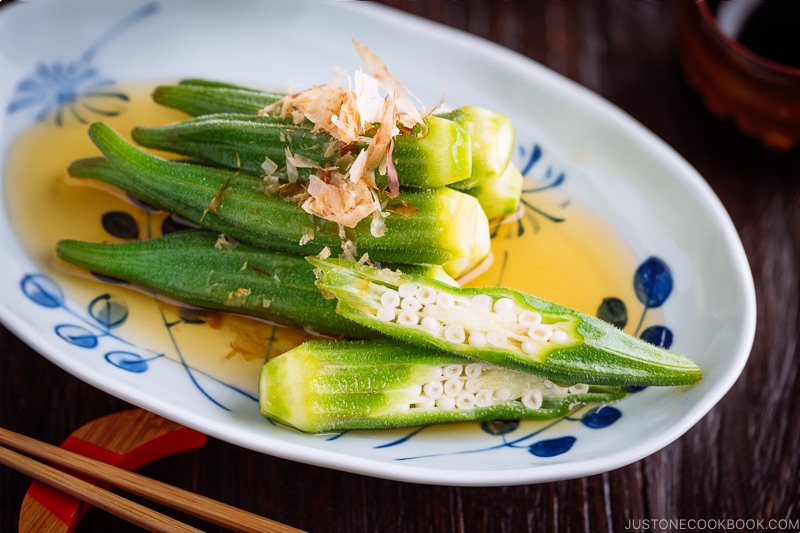
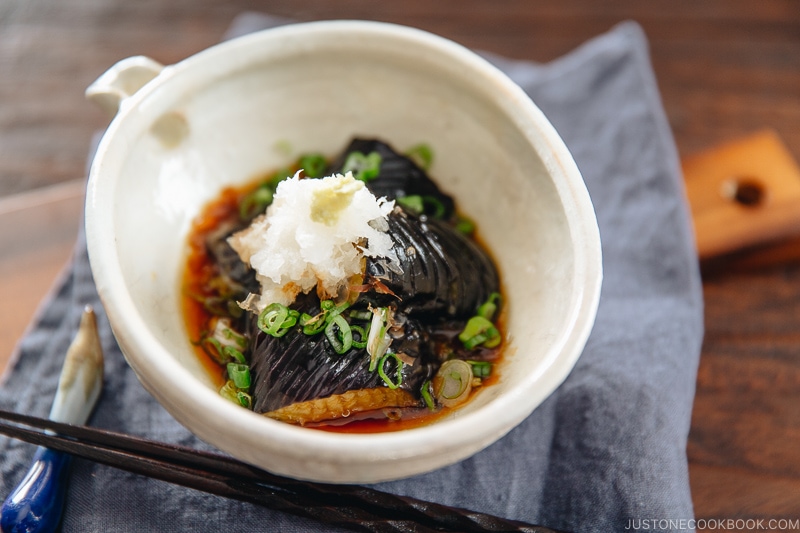
Eggplant Agebitashi (variation of Ohitashi)
Wish to learn more about Japanese cooking? Sign up for our free newsletter to receive cooking tips & recipe updates! And stay in touch with me on Facebook, Pinterest, YouTube, and Instagram.
Spinach Ohitashi (Japanese Spinach Salad)
Ingredients
For the Kombu Dashi
- ½ cup water (or use Awase Dashi or Vegan Dashi and skip the kombu)
- 1 piece kombu (dried kelp) (5 g; 2 x 2 inches or 5 x 5 cm per piece; or substitute a dashi packet or powder)
For the Seasonings
- 1 Tbsp mirin
- 1 Tbsp usukuchi (light-colored) soy sauce
For the Spinach
- 1 bunch spinach (8 oz, 227 g)
- 1 tsp Diamond Crystal kosher salt
For the Toppings
- katsuobushi (dried bonito flakes) (skip for vegan/vegetarian)
- toasted white sesame seeds
Instructions
- Before You Start…Please note that this recipe requires at least one hour of soaking time. Gather all the ingredients.
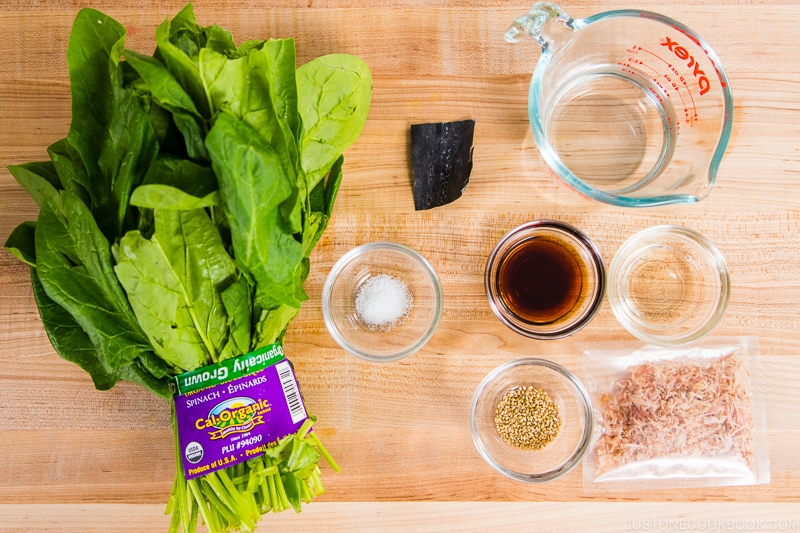
To Make the Kombu Dashi
- In a saucepan, put ½ cup water and 1 piece kombu (dried kelp).
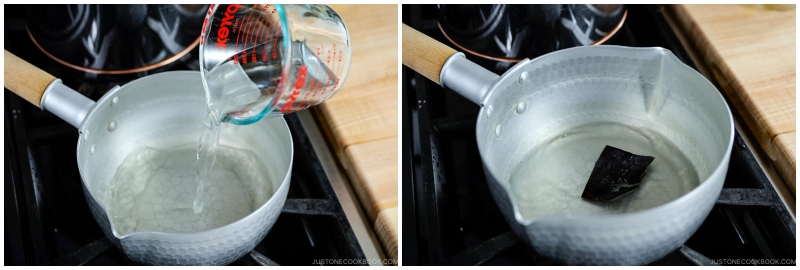
- Slowly bring it to a boil. Once boiling, remove the kombu from the liquid (and reserve it to make Kombu Tsukudani). Now, you have kombu dashi. If you are not vegan/vegetarian, you can add a small amount of katsuobushi for more flavor (see my Awase Dashi recipe for instructions).

To Make the Savory Broth
- To the dashi, add 1 Tbsp mirin and 1 Tbsp usukuchi (light-colored) soy sauce.
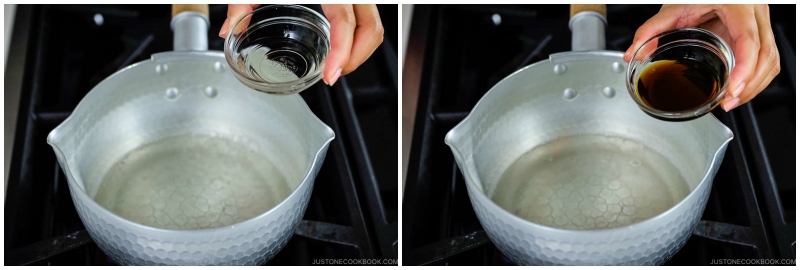
- Mix together, bring to a boil, and turn off the heat. Set aside.

To Prepare the Spinach
- Rinse well 1 bunch spinach.
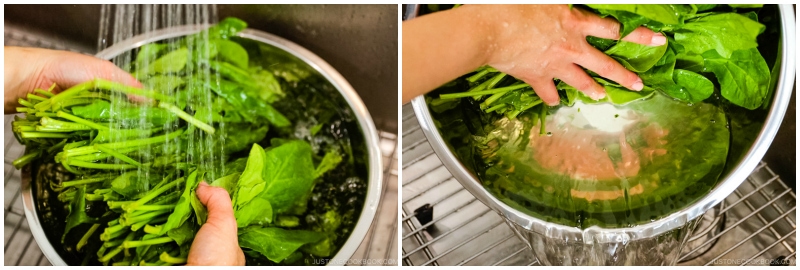
- Bring a large pot of water to a boil. Once boiling, add 1 tsp Diamond Crystal kosher salt. Add the spinach to the boiling water stem side first and cook for 20 seconds, as the stems take longer to cook.Nami's Tip: Salt helps keep the spinach's green color brighter.
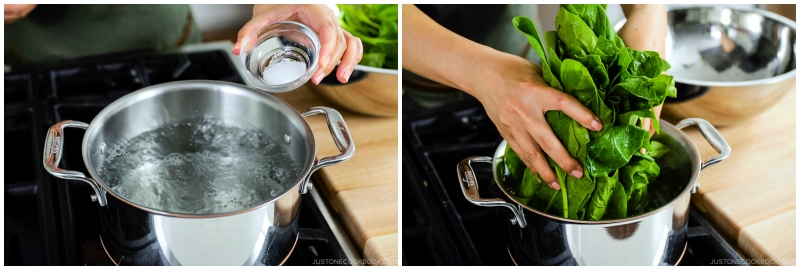
- Then, gently push the leafy part into the water and cook for 30–45 seconds. Remove quickly from the boiling water.Nami's Tip: Spinach in the US is more tender than Japanese spinach, so it cooks faster.
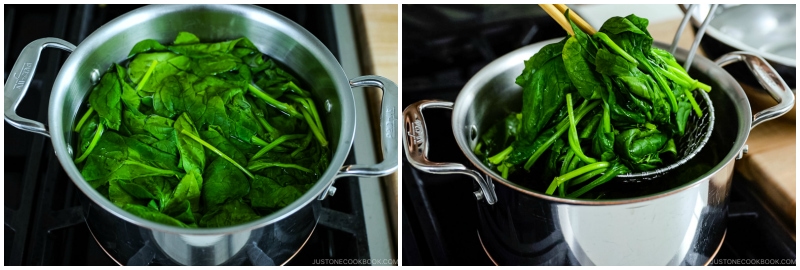
- Transfer the spinach to an ice bath and let it cool for 1 minute.Nami's Tip: Blanching and shocking in ice water removes much of the oxalic acid, locks in nutrients, and keeps the spinach vibrant. Do not leave it for more than a minute, or it will start to lose nutrients.
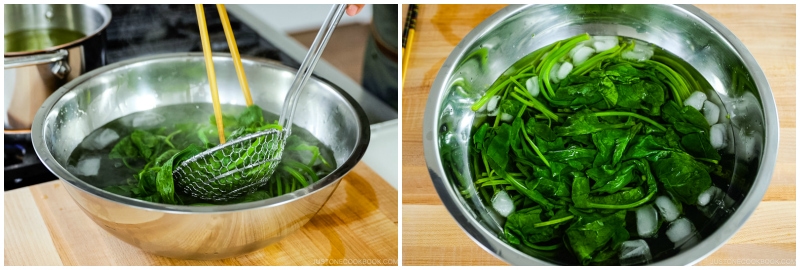
- Collect the spinach and gently squeeze out the water. If you like to serve this dish as I do, gather together the spinach neatly by the stems. I like to serve both the stem and leafy parts separately instead of mixing it up together.
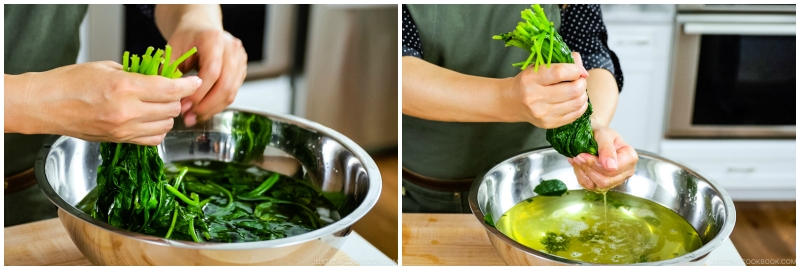
- Cut the spinach into 1½ to 2 inch (3.75 to 5 cm) pieces and squeeze out any remaining water.
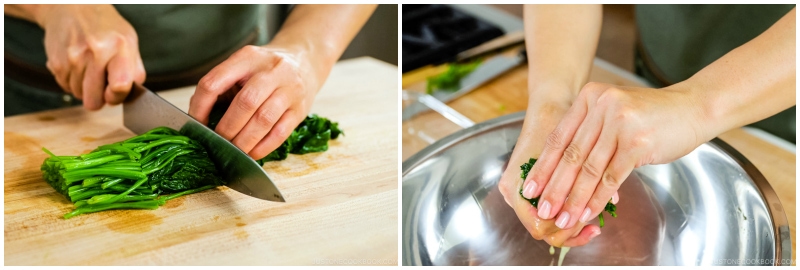
To Soak in the Broth
- Put the spinach in an airtight container. Now, pour the savory broth over the spinach.
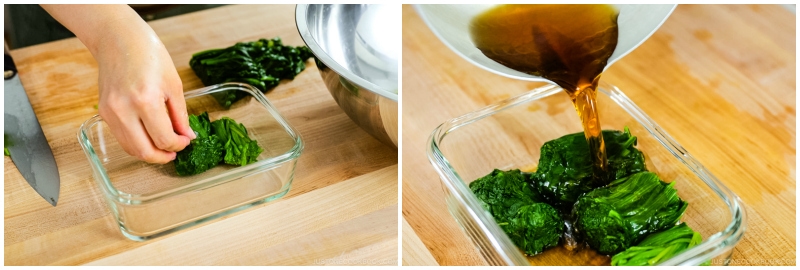
- Make sure the spinach is evenly distributed in the container and fully submerged in the broth. Place the lid on and let it soak in the refrigerator for at least 1 hour and ideally up to 3–4 hours.

To Serve
- Serve the spinach in small individual bowls and pour some broth on top. I like to make sure each bowl gets both the stem and leafy parts. The dark and light green color contrast makes a beautiful presentation.
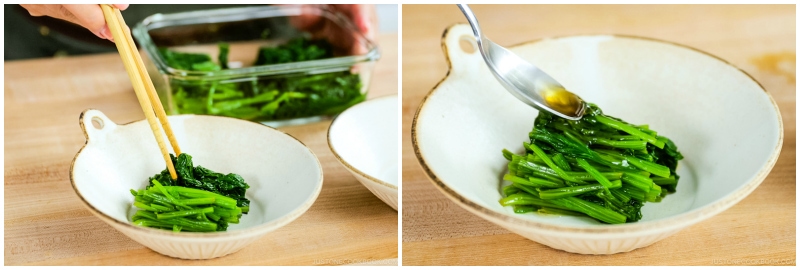
- Sprinkle with toasted white sesame seeds for a vegan/vegetarian version. For the standard version, add katsuobushi (dried bonito flakes) on top. Enjoy!
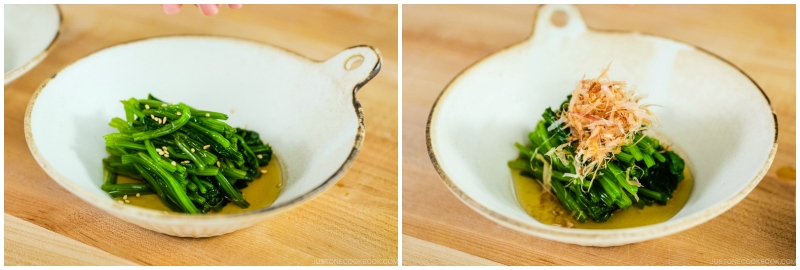
To Store
- You can keep Spinach Ohitashi in the refrigerator for up to 3 days.
Nutrition
Did you make this recipe?
Tag @justonecookbook on Instagram so we can see your delicious creation!
Editor’s Note: This post was originally published on January 26, 2012. It’s been updated with a new video on September 2019.


